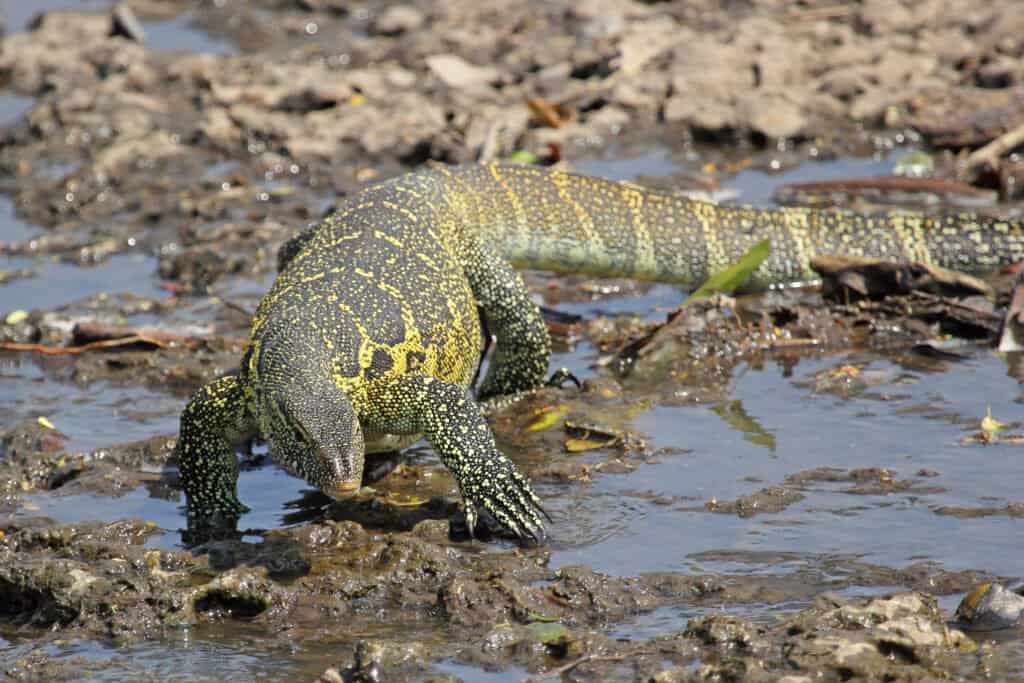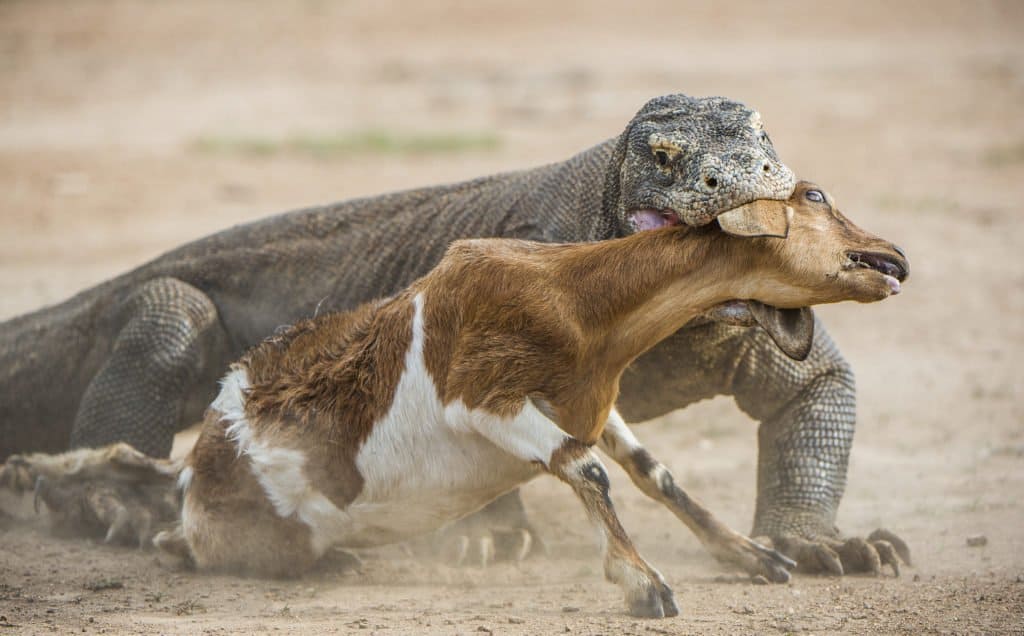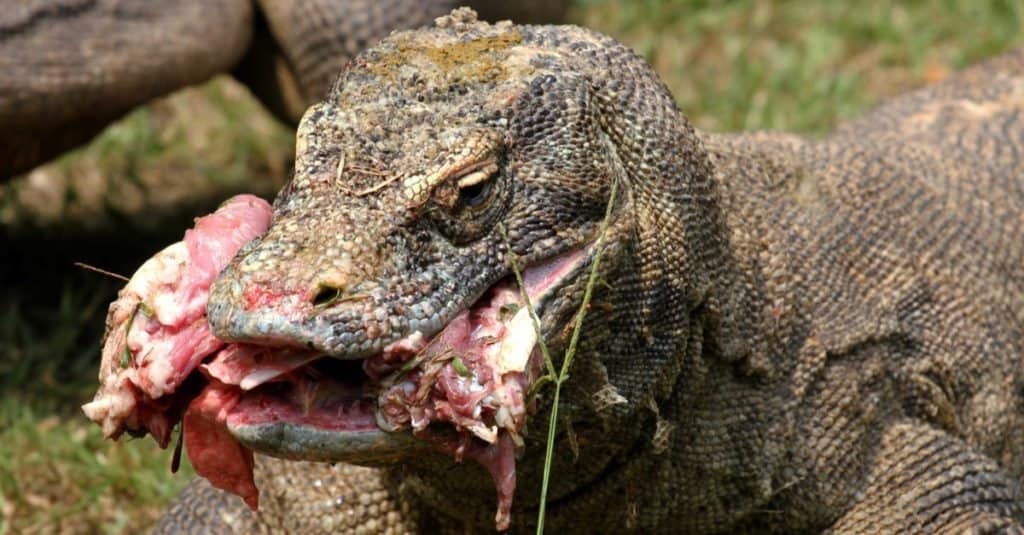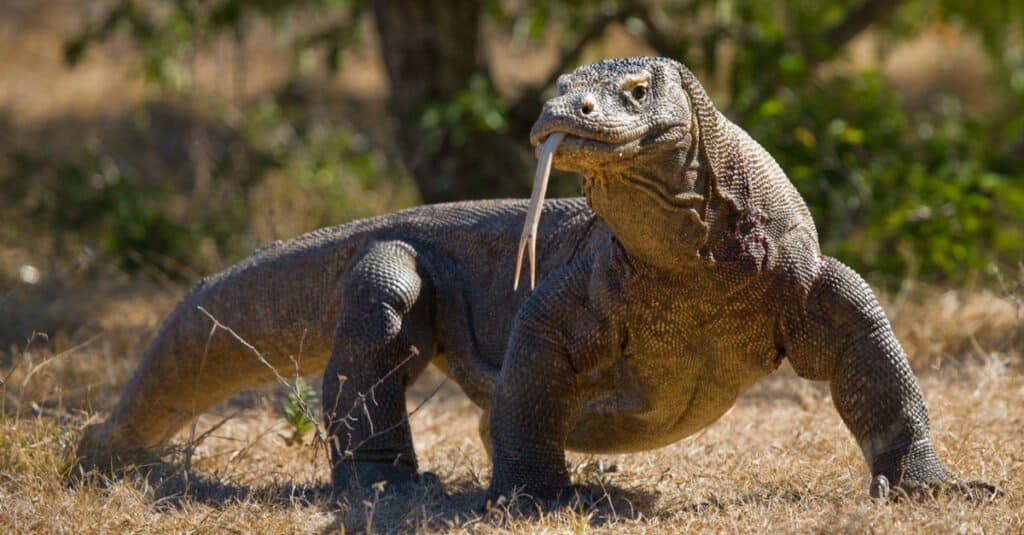Discover the Largest Komodo Dragon Ever!
Ever wonder what inspired King Kong? Despite its gorilla-like appearance, inspiration for the fictional beast came from Komodo dragons studied on a 1926 expedition to Komodo Island! Komodo dragons are incredibly interesting animals that many admire for their various unique characteristics. Their phenomenal size, venomous bites, and other fascinating adaptive traits make them a marvel among lizards and the animal kingdom. They are particularly famous for being the largest species of lizard alive today. This article will explore Komodo dragons, how they achieve such gargantuan sizes, and just how big the largest Komodo dragon ever really was.
Let’s begin!
What is a Komodo dragon?

Before we meet the largest Komodo dragon in history, let’s investigate what is typical of these fascinating creatures. The Komodo dragon, Varanus komodoensis, is a member of the monitor lizard family. The Komodo dragon is endemic to the Indonesian islands of Komodo, Flores, Rinca, and Gili Montang, which means they only exist in the wild on these islands.
Komodo dragons have a broad range of sizes and exemplify sexual dimorphism to some degree. Sexual dimorphism is when a male and female of the same species have distinct physical characteristics. Often, this is a substantial size difference between the sexes, differences in coloration, or the presence of flamboyant traits in one sex, like a peacock’s tail feathers. Male Komodo dragons are typically 174-201 pounds and 8.5 feet long, whereas females are on average 150-161 pounds and 7.5 feet long.
These lizards have about 60 serrated teeth that frequently fall out and are replaced. They also have a long, yellow, forked tongue. Komodo dragon skin is armored with scales across most of the body except some areas on the head. Their tail is about as long as their body and is very muscular.
How big are other monitor lizards?

Other members of the monitor lizard family are large relative to other lizards, but not in comparison to the Komodo dragon. The family of monitor lizards includes the top 7 largest lizard species in the world! There are 80 official species of monitor lizards ranging from 7.9 inches long to over 10 feet long. One of the smallest species of monitor lizard is the Kings’ Dwarf. Including the tail, an adult of this species can grow to 16 inches in length. The Nile monitor is the longest lizard in Africa growing between 3 feet 11 inches and 7 feet 3 inches! The Malayan monitor, or Asian water monitor, is the second largest lizard in the world reaching an incredible length of 9 feet 10 inches and a maximum weight of 110 pounds!
What is unique about Komodo dragon biology?
The world’s largest lizard, unsurprisingly, has very unique biology. Not only is their great size impressive in and of itself, size and several other traits are a result of environmental forces over evolutionary time. Specific characteristics that are particularly interesting include their size, their unique reproduction, keen senses, venomous bites, and predatory abilities.
Komodo Dragon Size: The Island Effect

Komodo dragons are incredibly large in comparison to most lizards. This is due to a biological phenomenon called the island effect. When a species becomes isolated to island habitats, they can become much larger (island gigantism) or much smaller (insular dwarfism) than their mainland relatives. This is due to the fact that on an island, large mammalian predators are often missing which leaves an ecological niche open. That ecological niche left vacant by large predators is then available to smaller animals. A small animal’s growth reaches a limit due to available resources and predation. When those limiting factors no longer exist, being larger holds an evolutionary advantage and will become a more common trait in the population over time.
This has been the case for Komodo dragons which inhabit the islands of Komodo, Flores, Rinca, and Gili Montang. Komodo dragons are apex predators which means there is no animal that typically preys upon them. As an apex predator, these lizards have access to sufficient resources and are able to fill the ecological niche normally held by large mammalian predators; they feed upon water buffalo, boars, deer, goats and other relatively large prey. Because of their access to large prey, larger Komodo dragons have an advantage that will be selected for over several generations leading to the species’ collective large size.
Fun Fact: The Island Effect has Acted on Human Ancestors!
The island effect exists in many animals including in human ancestors! A population of early humans, arguably a subpopulation of Homo erectus, expanded to Asia and inhabited what became Flores Island. When the subpopulation became isolated, they evolved over many generations due to selective pressures on the island and became a distinct species from the original population in mainland Asia. This island species is known as Homo floresiensis and is notable because they exhibited insular dwarfism.
Other animals on the island, like the Komodo dragon, had evolved to fill the niche of large predators. As a result, the early hominins on the island were better able to survive and reproduce if they were smaller, therefore requiring less resources, and being less detectable by predators. Over several generations, genes relating to smaller stature were selected for until the hominins became a genetically distinct dwarf species, Homo floresiensis. This hominin was only 3 feet 7 inches tall!
Reproduction: Parthenogenesis

Sergey Uryadnikov/Shutterstock.com
Another interesting biological characteristic of Komodo dragons is their reproductive abilities. Komodo dragons are able to reproduce sexually, similar to most other lizards. When they do reproduce sexually, there is aggressive and often violent competition between males. When the male courts a female, the female is antagonistic and resists copulation. This process can cause harm to both males and females. Distinct from most lizards, however, Komodo dragons may be monogamous and form “pair bonds”.
Komodo dragons are also capable of parthenogenesis, which is a form of asexual reproduction. Female Komodo dragons have been documented laying eggs that have not been fertilized by a male and producing viable offspring. Initially, scientists hypothesized that the female was able to store sperm for later use, but this was disproven when a female known to be isolated from males also produced viable eggs. Parthenogensis only produces males in this species.
Predatory Adaptions: Venom

Yudi S/Shutterstock.com
The Komodo dragon is the largest venomous lizard and the largest venomous land animal in the world! When humans are bitten, this venom can cause rapid swelling, localised decrease in blood clotting, and shooting pain possibly lasting for hours. Komodo dragon venom cannot cause human death on its own. Komodo dragons are vicious, however, and many bites with their serrated teeth has been lethal to humans. The Komodo dragon’s venom excretes from two glands in their mandible and contains many toxic proteins that can be debilitating to various large prey. The largest recorded meal of a Komodo dragon in a single sitting was a 90-pound wild pig!
Heightened Senses: Sight, Taste, Smell
Komodo dragons have limited hearing and were once thought to be deaf. They do have remarkable senses of vision, taste, and smell that compensate. These lizards have poor night vision but are able to see up to 980 feet away in the light! Komodo dragons rely heavily upon taste and smell which they detect with their tongue and vomeronasal organ rather than their nostrils. The vomeronasal organ exists in many lizards and is located in the nasal cavity above the roof of the mouth. Komodo dragons are able to detect rotting meat up to 5.9 miles away!
What is the largest Komodo dragon ever recorded?
The largest Komodo dragon ever recorded was 10 feet and 2 inches long and weighed a massive 365 pounds! This lizard was a gift to an American zoologist in 1928 from the Sultan of Bima. This ginormous Komodo dragon was briefly on display in St. Louis Zoological Gardens, Missouri, USA in 1937.
For perspective, the average Komodo dragon weighs 174-201 pounds, so the largest ever Komodo dragon weighed the average dragon by two-fold!
Is the Komodo dragon the largest monitor lizard ever?
As we’ve discussed earlier, the Komodo dragon is significantly larger than other extant monitor species. Yet, was it the largest lizard ever, including extinct species?
In fact, Komodo dragons are dwarfed by gigantic lizards that recently roamed the Earth! A giant monitor lizard, Megalania, that became extinct roughly 50,000 years ago, could grow up to 23 feet long! At that size, Megalania would have had a maximum weight possibly exceeding 4,000 pounds (1,940 kg)!
Megalania may have weighed more than 10 times the largest Komodo dragon ever recorded!
How are Komodo dragons doing today?

GUDKOV ANDREY/Shutterstock.com
Today, Komodo dragons face grave dangers in the wild. Komodo dragons are at risk due to habitat destruction, poaching and illegal trade, tourism, and environmental disasters exacerbated by climate change. In 1980, the establishment of Komodo National Park was an attempt to protect the species. In 2015, the total population of these lizards in the wild was an estimated 3,014 individuals. The population of Komodo dragons on the island of Padar has become extinct. Also, population sizes are decreasing in the Nusa Kode and Gili Motang islands. Komodo dragons, the world’s largest lizard and a fascinating natural marvel, is currently classified as an endangered species.
More from A-Z Animals
Ever wonder what inspired King Kong? Despite its gorilla-like appearance, inspiration for the fictional beast came from Komodo dragons studied on a 1926 expedition to Komodo Island! Komodo dragons are incredibly interesting animals that many admire for their various unique characteristics. Their phenomenal size, venomous bites, and other fascinating adaptive traits make them a marvel among lizards and the animal kingdom. They are particularly famous for being the largest species of lizard alive today. This article will explore Komodo dragons, how they achieve such gargantuan sizes, and just how big the largest Komodo dragon ever really was.
Let’s begin!
What is a Komodo dragon?

Before we meet the largest Komodo dragon in history, let’s investigate what is typical of these fascinating creatures. The Komodo dragon, Varanus komodoensis, is a member of the monitor lizard family. The Komodo dragon is endemic to the Indonesian islands of Komodo, Flores, Rinca, and Gili Montang, which means they only exist in the wild on these islands.
Komodo dragons have a broad range of sizes and exemplify sexual dimorphism to some degree. Sexual dimorphism is when a male and female of the same species have distinct physical characteristics. Often, this is a substantial size difference between the sexes, differences in coloration, or the presence of flamboyant traits in one sex, like a peacock’s tail feathers. Male Komodo dragons are typically 174-201 pounds and 8.5 feet long, whereas females are on average 150-161 pounds and 7.5 feet long.
These lizards have about 60 serrated teeth that frequently fall out and are replaced. They also have a long, yellow, forked tongue. Komodo dragon skin is armored with scales across most of the body except some areas on the head. Their tail is about as long as their body and is very muscular.
How big are other monitor lizards?

Other members of the monitor lizard family are large relative to other lizards, but not in comparison to the Komodo dragon. The family of monitor lizards includes the top 7 largest lizard species in the world! There are 80 official species of monitor lizards ranging from 7.9 inches long to over 10 feet long. One of the smallest species of monitor lizard is the Kings’ Dwarf. Including the tail, an adult of this species can grow to 16 inches in length. The Nile monitor is the longest lizard in Africa growing between 3 feet 11 inches and 7 feet 3 inches! The Malayan monitor, or Asian water monitor, is the second largest lizard in the world reaching an incredible length of 9 feet 10 inches and a maximum weight of 110 pounds!
What is unique about Komodo dragon biology?
The world’s largest lizard, unsurprisingly, has very unique biology. Not only is their great size impressive in and of itself, size and several other traits are a result of environmental forces over evolutionary time. Specific characteristics that are particularly interesting include their size, their unique reproduction, keen senses, venomous bites, and predatory abilities.
Komodo Dragon Size: The Island Effect

Komodo dragons are incredibly large in comparison to most lizards. This is due to a biological phenomenon called the island effect. When a species becomes isolated to island habitats, they can become much larger (island gigantism) or much smaller (insular dwarfism) than their mainland relatives. This is due to the fact that on an island, large mammalian predators are often missing which leaves an ecological niche open. That ecological niche left vacant by large predators is then available to smaller animals. A small animal’s growth reaches a limit due to available resources and predation. When those limiting factors no longer exist, being larger holds an evolutionary advantage and will become a more common trait in the population over time.
This has been the case for Komodo dragons which inhabit the islands of Komodo, Flores, Rinca, and Gili Montang. Komodo dragons are apex predators which means there is no animal that typically preys upon them. As an apex predator, these lizards have access to sufficient resources and are able to fill the ecological niche normally held by large mammalian predators; they feed upon water buffalo, boars, deer, goats and other relatively large prey. Because of their access to large prey, larger Komodo dragons have an advantage that will be selected for over several generations leading to the species’ collective large size.
Fun Fact: The Island Effect has Acted on Human Ancestors!
The island effect exists in many animals including in human ancestors! A population of early humans, arguably a subpopulation of Homo erectus, expanded to Asia and inhabited what became Flores Island. When the subpopulation became isolated, they evolved over many generations due to selective pressures on the island and became a distinct species from the original population in mainland Asia. This island species is known as Homo floresiensis and is notable because they exhibited insular dwarfism.
Other animals on the island, like the Komodo dragon, had evolved to fill the niche of large predators. As a result, the early hominins on the island were better able to survive and reproduce if they were smaller, therefore requiring less resources, and being less detectable by predators. Over several generations, genes relating to smaller stature were selected for until the hominins became a genetically distinct dwarf species, Homo floresiensis. This hominin was only 3 feet 7 inches tall!
Reproduction: Parthenogenesis

Sergey Uryadnikov/Shutterstock.com
Another interesting biological characteristic of Komodo dragons is their reproductive abilities. Komodo dragons are able to reproduce sexually, similar to most other lizards. When they do reproduce sexually, there is aggressive and often violent competition between males. When the male courts a female, the female is antagonistic and resists copulation. This process can cause harm to both males and females. Distinct from most lizards, however, Komodo dragons may be monogamous and form “pair bonds”.
Komodo dragons are also capable of parthenogenesis, which is a form of asexual reproduction. Female Komodo dragons have been documented laying eggs that have not been fertilized by a male and producing viable offspring. Initially, scientists hypothesized that the female was able to store sperm for later use, but this was disproven when a female known to be isolated from males also produced viable eggs. Parthenogensis only produces males in this species.
Predatory Adaptions: Venom

Yudi S/Shutterstock.com
The Komodo dragon is the largest venomous lizard and the largest venomous land animal in the world! When humans are bitten, this venom can cause rapid swelling, localised decrease in blood clotting, and shooting pain possibly lasting for hours. Komodo dragon venom cannot cause human death on its own. Komodo dragons are vicious, however, and many bites with their serrated teeth has been lethal to humans. The Komodo dragon’s venom excretes from two glands in their mandible and contains many toxic proteins that can be debilitating to various large prey. The largest recorded meal of a Komodo dragon in a single sitting was a 90-pound wild pig!
Heightened Senses: Sight, Taste, Smell
Komodo dragons have limited hearing and were once thought to be deaf. They do have remarkable senses of vision, taste, and smell that compensate. These lizards have poor night vision but are able to see up to 980 feet away in the light! Komodo dragons rely heavily upon taste and smell which they detect with their tongue and vomeronasal organ rather than their nostrils. The vomeronasal organ exists in many lizards and is located in the nasal cavity above the roof of the mouth. Komodo dragons are able to detect rotting meat up to 5.9 miles away!
What is the largest Komodo dragon ever recorded?
The largest Komodo dragon ever recorded was 10 feet and 2 inches long and weighed a massive 365 pounds! This lizard was a gift to an American zoologist in 1928 from the Sultan of Bima. This ginormous Komodo dragon was briefly on display in St. Louis Zoological Gardens, Missouri, USA in 1937.
For perspective, the average Komodo dragon weighs 174-201 pounds, so the largest ever Komodo dragon weighed the average dragon by two-fold!
Is the Komodo dragon the largest monitor lizard ever?
As we’ve discussed earlier, the Komodo dragon is significantly larger than other extant monitor species. Yet, was it the largest lizard ever, including extinct species?
In fact, Komodo dragons are dwarfed by gigantic lizards that recently roamed the Earth! A giant monitor lizard, Megalania, that became extinct roughly 50,000 years ago, could grow up to 23 feet long! At that size, Megalania would have had a maximum weight possibly exceeding 4,000 pounds (1,940 kg)!
Megalania may have weighed more than 10 times the largest Komodo dragon ever recorded!
How are Komodo dragons doing today?

GUDKOV ANDREY/Shutterstock.com
Today, Komodo dragons face grave dangers in the wild. Komodo dragons are at risk due to habitat destruction, poaching and illegal trade, tourism, and environmental disasters exacerbated by climate change. In 1980, the establishment of Komodo National Park was an attempt to protect the species. In 2015, the total population of these lizards in the wild was an estimated 3,014 individuals. The population of Komodo dragons on the island of Padar has become extinct. Also, population sizes are decreasing in the Nusa Kode and Gili Motang islands. Komodo dragons, the world’s largest lizard and a fascinating natural marvel, is currently classified as an endangered species.






